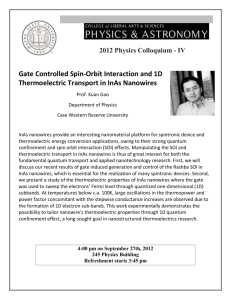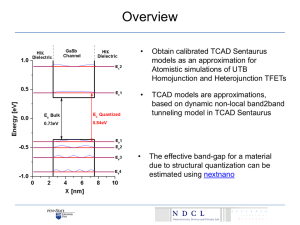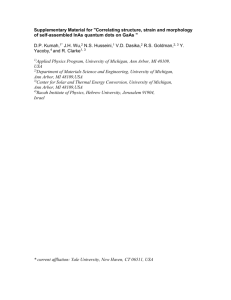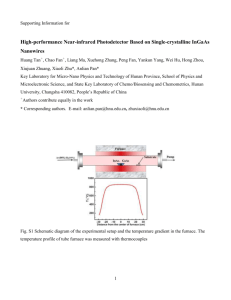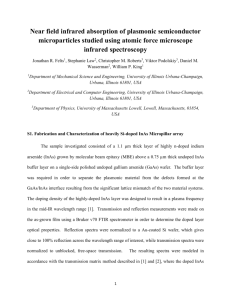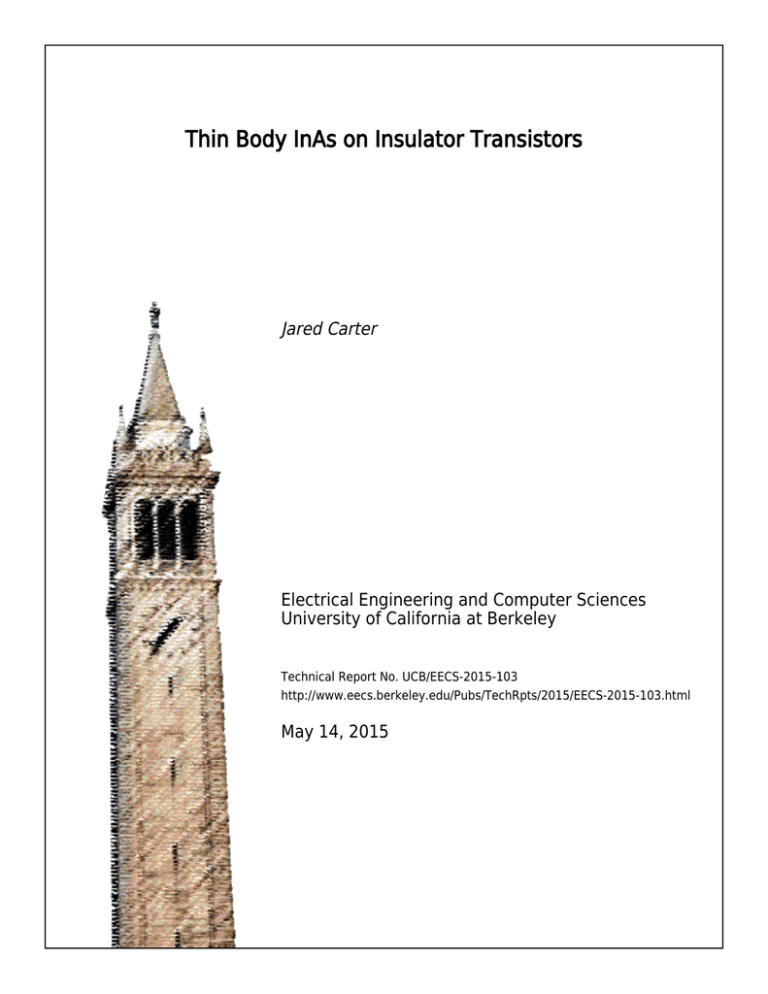
Thin Body InAs on Insulator Transistors
Jared Carter
Electrical Engineering and Computer Sciences
University of California at Berkeley
Technical Report No. UCB/EECS-2015-103
http://www.eecs.berkeley.edu/Pubs/TechRpts/2015/EECS-2015-103.html
May 14, 2015
Copyright © 2015, by the author(s).
All rights reserved.
Permission to make digital or hard copies of all or part of this work for
personal or classroom use is granted without fee provided that copies are
not made or distributed for profit or commercial advantage and that
copies bear this notice and the full citation on the first page. To copy
otherwise, to republish, to post on servers or to redistribute to lists,
requires prior specific permission.
Thin Body InAs on Insulator Transistors
by
Jared Carter
A thesis submitted in partial satisfaction of the
requirements for the degree of
Master of Science
in
Electrical Engineering and Computer Sciences
in the
Graduate Division
of the
University of California, Berkeley
Committee in charge:
Professor Eli Yablonovitch, Chair
Professor Ming Wu
Spring 2015
Thin Body InAs on Insulator Transistors
Copyright 2015
by
Jared Carter
1
Abstract
Thin Body InAs on Insulator Transistors
by
Jared Carter
Master of Science in Electrical Engineering and Computer Sciences
University of California, Berkeley
Professor Eli Yablonovitch, Chair
Described in the following report are a series of design decisions and experiments towards
demonstrating a prototype bilayer InAs Tunneling Field Effect Transistor (TFET), a new
type of transistor which could exhibit a steeper sub-threshold slope and could enable lowerpower electronics. In the process of designing and fabricating this device, n-channel InAs on
insulator MOSFETs were fabricated and characterized to better inform the TFET design
and fabrication. While in this work, a TFET with the desired characteristics was never
realized, others were able to demonstrate similar tunneling devices with poor subthreshold
slopes. A simple model is presented which explains the sensitivity of the performance of the
TFET to interface traps.
i
Contents
Contents
i
1 Introduction
1.1 The Need for a Lower-Voltage Replacement to the Transistor and The Physics
Governing the Voltage Sensitivity of Transistors . . . . . . . . . . . . . . . .
1.2 The Tunneling Field Effect Transistor . . . . . . . . . . . . . . . . . . . . . .
1
2 TFET Physics and Design
2.1 Two TFET Switching Mechanisms . . . . . . . . . . . . . . . . . . . . . . .
2.2 Band-Tails and Dimensionality: Two Important Design Considerations for
TFETs . . . . . . . . . . . . . . . . . . . . . . . . . . . . . . . . . . . . . . .
2.3 Putting It all Together: The Bilayer Tunneling Field Effect Transistor . . . .
4
4
3 Fabrication Processes for InAs TFETs and FETs
3.1 Introduction . . . . . . . . . . . . . . . . . . . . . . . . . . . . . . . . . . . .
3.2 TFET Fabrication Process Flow . . . . . . . . . . . . . . . . . . . . . . . . .
3.3 nFET Fabrication Process Flow . . . . . . . . . . . . . . . . . . . . . . . . .
9
9
10
15
4 Measurement Results and Interpretation
4.1 TFET Measurement Results . . . . . . . . . . . . . . . . . . . . . . . . . . .
4.2 nFET Measurement Results . . . . . . . . . . . . . . . . . . . . . . . . . . .
4.3 Extraordinary Sensitivity of TFET Subthreshold Slope to Interface Traps . .
19
19
20
20
Bibliography
24
1
2
5
7
1
Chapter 1
Introduction
1.1
The Need for a Lower-Voltage Replacement to
the Transistor and The Physics Governing the
Voltage Sensitivity of Transistors
Over the history of digital computing, reduction of energy consumption per operation has
been enabled by the miniaturization of components in integrated circuits. Another reason
for this reduction in energy consumption per operation, which is maybe not as well-known,
has also been the reduction in circuit power supply voltage.
However, in recent history this reduction in power supply voltage Vdd has slowed, as shown
in Table 1.1. At the end of the roadmap, the power supply voltage for high performance
logic is projected to be 0.57 V [1].
Technology
Node
Supply Voltage
Vdd (V)
0.25
µm
0.18
µm
0.13
µm
90
nm
65
nm
45
nm
32
nm
22
nm
14
nm
10
nm
2.5
1.8
1.3
1.2
1.1
1.0
0.97
0.9
0.8
0.71
Table 1.1: Supply Voltage scaling has slowed since 0.13 µm node. From the International
Technology Roadmap for Semiconductors [1], High Performance Logic Technology Requirements.
While there are many technological challenges in practice which make lowering the supply
voltage below 0.57 V difficult while maintaining the cost and performance of current digital
integrated circuits, a fundamental challenge to lowering the supply voltage has to do with the
basic physics of the transistor. This physics limits the voltage sensitivity of the transistor and
prevents transistor-based digital circuits from operating at arbitrarily low supply voltages
with both high throughput and low standby power levels.
CHAPTER 1. INTRODUCTION
2
Shown in Figure 1.1 is an energy band diagram of a transistor showing the Fermi distribution of carriers in the source of the transistor and the potential barrier to the channel seen
at best can
by the source electrons. Lowering the barrier by applying a gate voltage of kT
q
only increase the carrier density in the channel, and thus the drain current, by a factor of e.
This sensitivity of drain current of the transistor to gate voltage is called the sub-threshold
slope and at room temperature requires 60 mV of applied gate voltage to increase the drain
current by one decade.
Figure 1.1: Lowering the barrier by applying a gate voltage of kT
at best can only increase
q
the carrier density in the channel, and thus the drain current, by a factor of e. From [2].
Doing better than this sensitivity would either mean operating the circuit at lower temperatures, which would require expensive, bulky, and energy-consuming refrigeration, or
moving away from the concept of modulating transistor conductivity by raising and lowering
a potential barrier for thermally excited electrons.
1.2
The Tunneling Field Effect Transistor
The Tunneling Field Effect Transistor (TFET) is one scheme for a steep sub-threshold slope
device. The main idea is to inject charge carriers from the source into the channel via
quantum-mechanical band-to-band tunneling, avoiding the physics of thermal generation
CHAPTER 1. INTRODUCTION
3
of electrons over the source-channel barrier. The hope is that the physics permits charge
injection using band-to-band tunneling to be engineered to produce a steeper sub-threshold
slope device.
The TFET is not a new idea, and many papers on this device have been published.
However there tends to be a huge discrepancy between simulation and experiment, with
simulation predicting steep subthreshold slopes and on-currents, and experiments falling
short [3]. Part of the reason for this discrepancy has to do with overlooked physics of the
TFET turn-on. Proposed in this report is a TFET device which was designed while keeping
those physics in mind.
4
Chapter 2
TFET Physics and Design
2.1
Two TFET Switching Mechanisms
Two possible mechanisms have been identified [4] by which TFETs could exploit to potentially achieve a steep sub-threshold slope. The two mechanisms are shown in Figure 2.1.
Figure 2.1: Two possible switching mechanisms in TFETs. From [4].
The first mechanism is called barrier thickness modulation, which is when the gate potential acts to modulate the thickness of the source-channel p-n junction depletion region,
CHAPTER 2. TFET PHYSICS AND DESIGN
5
thus modulating the band-to-band tunneling probability. While this mechanism has been
demonstrated to produce sub-60mV/decade sub-threshold swings at low conductances [5],
at high conductances the sub-threshold slope is typically worse. This was explained in the
following report [4], where, using Kane’s model of band-to-band tunneling [6], the author
derived the following equation relating the point sub-threshold slope S to the potential drop
across the source-channel junction φ and the band-to-band tunneling probability T .
φ S = log(T ) For the conduction and valence band to line up on opposite sides of the homojunction,
we need the potential drop φ to be greater than the bandgap. For T = 1% which is what
is required for a good on-state conductance density competitive with state-of-the-art MOSFETs, S = 560 mV/decade for silicon, which is a much worse sub-threshold slope than that
of a well-engineered MOSFET.
The second mechanism is called density of states switching which is when the gate potential aligns and misaligns the valence and conduction bands opposite the source-channel
junction, turning the junction on and off. This is the same mechanism which creates the
negative differential resistance region in a tunnel diode [7]. Right away, without looking
carefully at the engineering details or the microscopic physics, one realizes the following:
this switching mechanism is only as sensitive to the degree that the conduction and valence
band-edges are abrupt. Also, something which is less obvious is that if one wants to use
the alignment and misalignment of band-edges as a switching mechanism, one ought to pay
attention to the joint band-edge density of states and recognize that the dimensionality of
the source-channel junction plays a role in modifying the joint band-edge density of states.
2.2
Band-Tails and Dimensionality: Two Important
Design Considerations for TFETs
While naively, one might think that the semi-conductor band-edge is perfectly sharp, optical
measurements of the semi-conductor band-edge [8] reveal that the band-edge is not perfectly
sharp. When plotting the optical absorption coefficient versus optical frequency, instead
of the expected step function with abrupt turn-on at photon energy equal to the bandgap
energy, h̄ω = Eg , measurements
i show a more gradual turn-on near the band-edge with
h
g
, where its abruptness is characterized by the so-called
absorption α = α0 exp − h̄ω−E
E0
“Urbach parameter” E0 .
Measurements of the optical absorption coefficient of gallium arsenide [9] at different doping concentrations show that the Urbach parameter becomes larger and the absorption edge
becomes more broad at higher doping concentrations. One makes the following conclusion,
at least to the degree that the physics of optical absorption in semi-conductors translates to
CHAPTER 2. TFET PHYSICS AND DESIGN
6
the physics of band-to-band tunneling (both are commonly modeled as being proportional
to the integral of the joint density of states over energy): to see the sharpest TFET turn-on,
one must eliminate doping in the tunneling junction. This is a rather startling conclusion
which says that TFET designs ought to move away from the usual technique of preparing
tunneling junctions, which is to use heavy chemical doping of both sides of a homojunction
to achieve the desired band alignment.
A consequence of the joint density of states determining the TFET turn-on is that the
dimensionality of the source-channel junction of the TFET is an important design parameter
and should not be neglected. In semiconductor lasers, the dimensionality of the optical
gain medium is commonly engineered in order to reduce the joint density of states, which
reduces the transparency and threshold current densities of semiconductor lasers [10]. In
the referenced report [4], Harrison’s tunneling theory [11] is applied to p-n tunnel junctions
of different dimensionalities, shown in Figure 2.2 and for each case the tunneling current
turn-on is calculated.
Figure 2.2: Nine possible tunnel p-n junction configurations in TFETs. From [4].
An important conclusion of the calculation is that the 2D-2D face overlapped junction,
shown in Figure 2.2, is promising for TFETs. The calculation, using the ideal step-function
2D-2D joint density of states, predicts a sharper turn-on and higher conductance density at
low voltages than that of the 3D-3D or 2D-3D tunneling junctions.
CHAPTER 2. TFET PHYSICS AND DESIGN
2.3
7
Putting It all Together: The Bilayer Tunneling
Field Effect Transistor
The bilayer tunneling field effect transistor or bilayer TFET, is a novel TFET design, first
proposed in 2011 [12], which possesses the preferred 2D-2D tunnel junction dimensionality
and band alignment prepared via electrostatic gating and not chemical doping. Shown in
Figure 2.3 is a cartoon showing the bilayer TFET structure and cross-section energy band
diagram. Of central importance to the device is the tunnel junction at the region of the
overlap of the staggered top and bottom electrodes, which is formed by accumulation and
inversion layers on either side of the semiconductor film induced by the top and bottom gates,
respectively. Either by the application of the appropriate voltages to the gate electrodes or
by work function control, the conduction band minimum and valence band maximum can be
brought into near-alignment and then aligned and misaligned by the application of voltage
to the top gate.
Figure 2.3: Bilayer TFET structure showing current path upon transistor turn-on and the
off-state energy band diagram of tunnel junction cross-section. From [13].
There are a few theoretical drawbacks to this device structure. One is that the ideal,
no-interface traps, gate efficiency is actually less than one (an easy way to see this is to notice
that application of voltage to the top gate works to lower the conduction band minimum
energy level of the accumulation layer as well as to slightly lower the valence band maximum
CHAPTER 2. TFET PHYSICS AND DESIGN
8
level in the inversion layer through the capacitive coupling of the layer of thin semiconductor
film). This is to be contrasted with state-of-the-art multi-gate or fully-depleted silicon-oninsulator MOSFETs, where the gate efficiency is unity. Another drawback is that the device
has at least four terminals per device, and suffers from the area penalty of having at least
four instead of three terminals, and a shared bulk terminal. A huge practical challenge with
this design is the question of how to achieve self-alignment between the staggered gates on
opposite sides of the film, in either a fin-based or planar double-gate structure, with selfalignment being a necessary requirement for the manufacturability of this device. Even with
these drawbacks, this bilayer TFET device can be viewed as a good experimental ‘test-bed’
for studying the physics of the density of states switching mechanism.
9
Chapter 3
Fabrication Processes for InAs TFETs
and FETs
3.1
Introduction
Described in this chapter is a micro-fabrication process flow for an planar InAs TFET. InAs
was chosen as the transistor body material over the more usual transistor material, silicon,
for two reasons:
• The physics of band-to-band tunneling is much like the physics of optical absorption in
that the electron momentum is conserved when going from valence band to conduction
band. Therefore, for higher band-to-band tunneling rates and thus, higher current
densities, a direct-gap semiconductor is preferred.
• Although this was not attempted in the experiment, the small band-gap of InAs (0.3
eV) permits the quiescent band alignment between conduction band minimum and
valence band maximum to be achieved by work function control of the top and bottom
gates. In larger band-gap semi-conductors, like in silicon, the required work function
difference is larger than the range of work functions permitted by metals typically used
in micro-fabrication processes. [13]
The bilayer TFET possibly could be realized in two configurations—either as a fin-based
transistor, or in a planar, double-gated structure. The planar, double-gated structure was
chosen because it was more compatible with the existing process capability at Berkeley.
That is, a process for van der Waals bonding epitaxially grown InAs onto insulator-coated
substrates was already developed at Berkeley [14], while no process existed for the RIE
etching of thin InAs fins at high aspect ratios, which would be required for a fin-based
structure.
In order to better understand and design the TFET fabrication process flow, n-type InAs
MOSFETs were designed and fabricated as well. Therefore in addition to the bilayer TFET
fabrication process flow, an InAs nFET fabrication process flow is described as well.
CHAPTER 3. FABRICATION PROCESSES FOR INAS TFETS AND FETS
3.2
10
TFET Fabrication Process Flow
Shown in Figure 3.1 is a cross-section diagram of a fabricated bilayer TFET. The bilayer
TFET fabrication can be broadly separated into three steps. First, the silicon wafer is
processed to form the local back gate electrodes and back gate insulator. Next, InAs is
bonded onto the silicon die using a process developed by the Javey Research Lab at Berkeley
[14]. Finally, the InAs films are processed to form the top gate and source and drain contacts
of the transistors.
Figure 3.1: Cross-section diagram of an InAs bilayer TFET.
Silicon Back Gate Processing
Shown in Figure 3.2 is a cross-section diagram of the silicon wafer after forming the back
gate electrode and back gate insulator. Notice that the back gate electrode is actually a
heavily-doped p++ silicon layer implanted into the n-type wafer. While this design choice
easily gives us a smooth and flat service upon which to bond the InAs, a consequence of this
design is that this particular bilayer TFET does not scale to deep sub-micron dimensions.
The tunnel junction length defined by the lateral overlap of the top and bottom gates must
be larger than the depletion length of the p++-n junction in the silicon.
The fabrication process is as follows. We start with phosphorus-doped silicon wafers with
resistivities of ∼5 Ω cm. Then, photo-lithographically patterned fiducials are etched into the
CHAPTER 3. FABRICATION PROCESSES FOR INAS TFETS AND FETS
11
Figure 3.2: Cross-section diagram of the silicon wafer, after silicon processing steps and prior
to bonding InAs films onto wafer.
wafer using a chlorine-based chemistry. Next, to tailor the background n-type doping level,
blanket phosphorus implants with an implantation energy of 200 keV and doses of 1013 /cm2
or 1014 /cm2 were implanted through a 15 nm thick dry screen oxide grown on the wafers.
Next, the wafers were annealed in a nitrogen ambient for 7 hours at 1050 ◦ C to activate
and diffuse the dopants to create ∼1 µm thick n-type layers with doping concentrations of
∼ 1017 /cm3 and ∼ 1018 /cm3 , respectively. Following that step, patterned boron implants,
through a 15 nm thick dry screen oxide grown on the wafers and using ∼2 µm thick photoresist as an implant mask, were performed with implantation energies of 30 keV or 90 keV
and doses of 3 · 1015 /cm2 or 6 · 1015 /cm2 . Following stripping the photo-resist mask in an
oxygen plasma and stripping the screen oxide in diluted HF, a 3 nm dry oxide was grown on
the wafers followed by the deposition of an 18nm LPCVD stoichiometric nitride to form the
back gate dielectric. During the oxide growth and nitride deposition, the boron-implanted
p++ layers which form the back gate electrodes are activated and are designed to have doping
concentrations of ∼ 1020 /cm3 and junction depths of 400 nm and 800 nm, respectively.
Next, the back-gate dielectric is etched off of the back-side of the wafer using a fluorinebased RIE etch chemistry and then on the front-side, vias were photo-lithographically patterned and then etched through the back gate oxide/nitride dielectric using the same dry
etch chemistry. Following this step, nickel electrodes are evaporated and patterned using
CHAPTER 3. FABRICATION PROCESSES FOR INAS TFETS AND FETS
12
the lift-off process with photo-resist to create ohmic contact to the p++ silicon back-gate
electrodes through the etched vias. This is followed by the evaporation and patterning via
lift-off of Ti/Au fiducials for later electron beam lithography steps. Finally, the back-side of
the wafer is metallized with evaporated nickel to ensure electrical contact with the n-type silicon substrate, and the wafer is sawed into dies. Shown in Figure 3.3 is a top-down scanning
electron micrograph of a processed silicon die. Notice the clearly visible contrast between
the p++ and n-type silicon.
Figure 3.3: Top down SEM of processed silicon die.
van der Waals Bonding of InAs onto Silicon Die
Shown in Figure 3.4 is a cross-section diagram of the silicon die with bonded InAs film
straddling the p-n junction boundary. Described below is the fabrication process, developed
in [14], used to bond the InAs to the silicon. Figure 3.5 shows the steps used in the bonding
process.
First, we start with the processing of the InAs film on its native III-V substrate. Unintentionally doped InAs was pseudomorphically grown by molecular beam epitaxy on top of
an unintentionally doped 60 nm Al0.4 Ga0.6 Sb layer on a 2-inch GaSb substrate by the Krishna Group at the University of New Mexico. The wafer is then cleaved into 1 x 1 cm dies.
Next, following an imprint lithography step to pattern 0.5 µm wide polymethylmethacrylic
CHAPTER 3. FABRICATION PROCESSES FOR INAS TFETS AND FETS
13
Figure 3.4: Cross-section diagram of the silicon wafer, after bonding InAs films onto wafer.
(PMMA) lines with 1 µm pitch on the GaSb subtrate, the InAs film is etched with a 1:20
citric acid/hydrogen peroxide solution to transfer the lines into the InAs. The PMMA is
then stripped and the die is further cleaved into 2 x 2 mm dies. Next, a timed etch is performed using a 3% ammonium hydroxide solution, which etches the Al0.4 Ga0.6 Sb with a high
selectivity to InAs, and the InAs lines are undercut. When the InAs lines are barely attached
to the GaSb substrate by a narrow Al0.4 Ga0.6 Sb stub, the die is taken out of solution, rinsed
in water, and dried with an nitrogen gun, and a polydimethylsiloxane (PDMS) substrate is
brought into intimate contact and then detached from the GaSb substrate. This transfers
the InAs film onto the PDMS substrate.
Next, the Al0.4 Ga0.6 Sb remnants are etched off of the backside of the InAs films on the
PDMS substrate with dilute HF. After rinsing and drying, the PDMS substrate is brought
into contact with a silicon die and then detached. After this step, the InAs films are detached
from the PDMS substrate and are bonded onto silicon. Shown in Figure 3.6 is an optical
microscope image of a small portion of the silicon die with a particularly good InAs transfer
yield. As this InAs bonding process only has a rough angular alignment between InAs lines
and the patterns on the silicon, the silicon die must be inspected either optically or using
scanning electron microscopy to be able to locate positions of the InAs lines relative to gold
electron beam fiducial markers so that the InAs lines can be processed into transistors.
CHAPTER 3. FABRICATION PROCESSES FOR INAS TFETS AND FETS
14
Figure 3.5: Process for bonding InAs onto silicon. InAs strips are epitaxially lifted off of the
GaSb substrate and bonded onto silicon with the help of a PDMS stamp. From [14].
InAs Top Gate, Source, and Drain Processing
With the InAs films bonded to the silicon die, the next steps are to do the processing for the
source, drain, and top gate of the InAs transistors. The first mask step is the p-type doping
of InAs using a zinc vapor-phase diffusion to create the p-type source in the natively n-type
InAs. First, oxide is evaporated and then windows in the oxide are etched in a buffered
HF solution with an electron beam lithographically defined PMMA mask. Next, the InAs
is doped p-type through the windows in the oxide using a Zn vapor phase diffusion doping
process 400 ◦ C developed in [15].
After stripping the oxide mask in buffered HF, another layer of oxide used for the isolation
of the source and drain leads from the substrate, is evaporated and windows in the oxide
exposing the active area and back gate contact of the transistor are patterned via etching
in a buffered HF solution using a lithographically defined PMMA mask. Next, the nickel
source and drain electrodes, as well as the leads to the back gate electrode are evaporated
and patterned using the liftoff process, followed by a 1 min anneal at 300 ◦ C to improve the
nickel-InAs contact resistance. Prior to the evaporation of the nickel, a quick dip in dilute
HF is used to remove the native oxide from the surface of the InAs.
Then, the top gate dielectric, ZrO2 is deposited using a thermal atomic layer deposition
process at 130 ◦ C using tetrakis (ethylmethylamido) zirconium and water precursors. Follow-
CHAPTER 3. FABRICATION PROCESSES FOR INAS TFETS AND FETS
15
Figure 3.6: An optical microscope image of a small portion of the silicon die with a good
InAs transfer yield.
ing the deposition of the film, a forming gas anneal is performed at 170 ◦ C, which has been
shown to reduce interface trap densities at the InAs ZrO2 interface [16]. Next, nickel gate
electrodes are evaporated and patterned using the lift-off process, followed by the etching
of vias through the ZrO2 to the source and drain pads using buffered HF solution through
a lithographically patterned PMMA etch mask. A scanning electron micrograph showing a
finished device is shown in Figure 3.7.
3.3
nFET Fabrication Process Flow
The nFET fabrication process flow is much simpler and recycles a lot of the steps from the
TFET process flow. Shown in Figure 3.8 is a cross-section diagram of an InAs nFET.
The nFET fabrication process generally proceeds as that of the TFET in that first the
silcon wafer is processed and sawed into dies, followed by the bonding of InAs onto the
silicon die and then the electron beam lithography processing of the bonded InAs films into
transistors. Here, the silicon wafer processing is much simpler, consisting of only the growth
and deposition of the thermal oxide and LPCVD nitride films on the p++ silicon wafer
with resistivity of < 1 mΩ cm, followed by the backside RIE etching of the dielectric film
in a fluorine-based chemistry and nickel metallization of the backside, and then finally the
CHAPTER 3. FABRICATION PROCESSES FOR INAS TFETS AND FETS
16
Figure 3.7: A top-down SEM of a finished TFET device.
evaporation and lift-off of Ti/Au fiducial markers for electron beam lithography and sawing
the wafer into dies. The bonding of the InAs to the silicon die proceeds in the same way
except that the bonding yield requirement is relaxed since nFET transistors do not need
to straddle a lateral p-n junction in the silicon. The InAs nFET transistor processing is a
lot simpler as well, mostly because there is no need to create a p-type source. The nFET
transistor processing required is only the fabrication of the nickel source and drain electrodes,
followed by the top gate dielectric and electrode processing and source/drain via opening for
probing. Shown in Figure 3.9 is an optical image of a completed nFET.
CHAPTER 3. FABRICATION PROCESSES FOR INAS TFETS AND FETS
Figure 3.8: A cross-section diagram of an nFET device.
17
CHAPTER 3. FABRICATION PROCESSES FOR INAS TFETS AND FETS
Figure 3.9: Optical image of a completed nFET.
18
19
Chapter 4
Measurement Results and
Interpretation
4.1
TFET Measurement Results
One run of TFET devices was able to be completed. No trend in transfer characteristics was
found across the fabricated devices. High leakage currents were measured from substrate to
probe pads. Plotted in Figure 4.1 is a 2 terminal I-V measurement from drain probe pad
to the substrate of a TFET device. In the desired operation of the TFET device, the drain
voltage is higher than the grounded substrate, and this measurement shows a drain current
level comparable to, or maybe higher than the on state current for a few micro-meter wide
TFET device.
This leakage was later attributed to an oversight in the fabrication process which was
predicated on two false assumptions. The first bad assumption was the etch rate of ALD
ZrO2 in 5:1 buffered HF for clearing the gate dielectric from the source and drain probe
pads for probing. Ellipsometry measurements pre- and post-etching on silicon dies with
blanket ALD ZrO2 films, along with checking the die’s ‘hydrophobicity’ post etching were
used to calibrate the BHF etch rate. However, ellipsometry can only measure an average film
thickness. It was later discovered that the ZrO2 does not etch uniformly in BHF, and the
condition used in the process lead to a huge overetch of portions of the ZrO2 film. The second
bad assumption was that the nickel probe pads would be a good etch-stop layer for BHF.
Under this unintended overetch condition, BHF was found to form pinholes in the nickel
film, allowing the BHF to seep through and attack the field oxide and back gate dielectric
underneath the probe pad. Shown in Figure 4.2 is a nickel probe pad with pinholes from
prolonged exposure to BHF.
CHAPTER 4. MEASUREMENT RESULTS AND INTERPRETATION
20
Figure 4.1: Drain probe pad to substrate leakage plotted for a first run TFET device.
4.2
nFET Measurement Results
InAs nFETs were able to be fabricated with interpretable electrical characterization data.
Plotted in Figure 4.3 is the measured transfer characteristic of a typical nFET. Common to all
of the measured nFETs is a poor subthreshold slope. This poor gate efficiency was attributed
to the high interface trap density Dit at the InAs/ZrO2 interface. Electrons attracted to the
surface of the semiconductor become captured by the interface traps and cannot participate
in conduction. This means that more voltage needs to be applied to the gate to increase
the mobile channel charge and thus, the drain current. From the sub-threshold slope, Dit is
estimated to be 3 × 1013 eV−1 cm−2 .
4.3
Extraordinary Sensitivity of TFET Subthreshold
Slope to Interface Traps
The high Dit not only degrades the sub-threshold slope by reducing the gate efficiency. The
interface traps also provide a conduction path in parallel to the direct band-to-band tunneling
from valence to conduction band edges. The turn-on of this conduction path occurs prior
to alignment of conduction and valence band edges and is believed to be responsible for
CHAPTER 4. MEASUREMENT RESULTS AND INTERPRETATION
21
Figure 4.2: Top-down SEM showing pinholes in nickel film formed by BHF etching. Notice
the ‘un-holey’ border on the edges of the probe pad. This is where the PMMA via etch mask
protected the nickel.
the smeared-out, and temperature dependent [17] turn-on for TFETs which operate by the
density of states switching mechanism.
Figure 4.4 explains this undesired parallel conduction path in a TFET. The sourcechannel junction in a TFET, with interface traps throughout the bandgap, is shown. The
two-step process of tunneling into the traps and then the thermal generation from the trap
and into the band provides a shunt current path in the TFET. When the tunneling rate is
larger than the thermal generation rate, the current density in the junction is proportional
to the thermal generation rate from the traps to the conduction band, which, like the normal
generation over the source-channel barrier, is governed by the Boltzmann factor.
Assuming that the tunneling probability to an interface trap is the same as the tunneling
probability to a conduction band energy state, engineering out this parallel conduction path
would require a huge reduction in the density of interface traps. The extracted Dit and
the 2D density of states at the conduction band edge of InAs are both 3 × 1013 eV−1 cm−2 .
To achieve an on-off ratio of 104 , which barely would meet the minimum requirement for
transistors used in digital logic, we’d roughly need to reduce the interface trap density by
the same amount to 3 × 109 eV−1 cm−2 , which is comparable to or even lower than the best
interface trap densities for the silicon/thermal oxide interface. Engineering interface trap
densities to such low levels is very challenging and not very practical for this InAs bilayer
TFET device, where great chemical control of the InAs-dielectric interfaces is not obtainable
with this fabrication process.
CHAPTER 4. MEASUREMENT RESULTS AND INTERPRETATION
22
Figure 4.3: Transfer characteristic of InAs nFET with 2 µm gate length, and 1.5 µm width.
CHAPTER 4. MEASUREMENT RESULTS AND INTERPRETATION
23
Figure 4.4: The source-channel junction in a TFET, with interface traps throughout the
bandgap, is shown. The two-step process of tunneling into the traps and then the thermal
generation from the trap and into the band provides a shunt current path in the TFET.
24
Bibliography
[1] International Technology Roadmap for Semiconductors. 2012. url: http://www.itrs.
net/.
[2] Sapan Agarwal. “Reinventing the PN junction: Dimensionality Effects on Tunneling
Switches”. PhD thesis. EECS Department, University of California, Berkeley, May
2012. url: http://www.eecs.berkeley.edu/Pubs/TechRpts/2012/EECS- 201297.html.
[3] Alan C. Seabaugh and Qin Zhang. “Low-Voltage Tunnel Transistors for Beyond CMOS
Logic”. In: Proceedings of the IEEE 98.12 (Dec. 2010), pp. 2095–2110.
[4] Sapan Agarwal and Eli Yablonovitch. Designing a Low Voltage, High Current Tunneling Transistor. Tech. rep. EECS Department, University of California, Berkeley, Dec.
2013. url: http://www.eecs.berkeley.edu/Pubs/TechRpts/2013/EECS- 2013250.html.
[5] J. Appenzeller et al. “Band-to-Band Tunneling in Carbon Nanotube Field-Effect Transistors”. In: Phys. Rev. Lett. 93 (19 Nov. 2004), p. 196805.
[6] Evan O. Kane. “Theory of Tunneling”. In: Journal of Applied Physics 32.1 (1961),
pp. 83–91.
[7] Leo Esaki. “New Phenomenon in Narrow Germanium p − n Junctions”. In: Phys. Rev.
109 (2 Jan. 1958), pp. 603–604.
[8] Franz Urbach. “The Long-Wavelength Edge of Photographic Sensitivity and of the
Electronic Absorption of Solids”. In: Phys. Rev. 92 (5 Dec. 1953), pp. 1324–1324.
[9] J. I. Pankove. “Absorption Edge of Impure Gallium Arsenide”. In: Phys. Rev. 140 (6A
Dec. 1965), A2059–A2065.
[10] R. Dingle and C.H. Henry. Quantum effects in heterostructure lasers. US Patent
3,982,207. Sept. 1976. url: http://www.google.com/patents/US3982207.
[11] Walter A. Harrison. “Tunneling from an Independent-Particle Point of View”. In: Phys.
Rev. 123 (1 July 1961), pp. 85–89.
BIBLIOGRAPHY
25
[12] Livio Lattanzio, Luca De Michielis, and Adrian M Ionescu. “Electron-hole bilayer tunnel FET for steep subthreshold swing and improved ON current”. In: Solid-State Device
Research Conference (ESSDERC), 2011 Proceedings of the European. 2011, pp. 259–
262.
[13] Sapan Agarwal et al. Engineering the Electron-Hole Bilayer Tunneling Field-Effect
Transistor. Tech. rep. EECS Department, University of California, Berkeley, Dec. 2013.
url: http://www.eecs.berkeley.edu/Pubs/TechRpts/2013/EECS-2013-249.html.
[14] Hyunhyub Ko et al. “Ultrathin compound semiconductor on insulator layers for highperformance nanoscale transistors”. In: Nature 468.7321 (2010), pp. 286–289.
[15] Alexandra C. Ford et al. “Patterned p-Doping of InAs Nanowires by Gas-Phase Surface
Diffusion of Zn”. In: Nano Letters 10.2 (2010), pp. 509–513.
[16] Kuniharu Takei et al. “High quality interfaces of InAs-on-insulator field-effect transistors with ZrO2 gate dielectrics”. In: Applied Physics Letters 102.15 (2013).
[17] Xin Zhao, A. Vardi, and J.A. del Alamo. “InGaAs/InAs heterojunction vertical nanowire
tunnel fets fabricated by a top-down approach”. In: Electron Devices Meeting (IEDM),
2014 IEEE International. Dec. 2014, pp. 25.5.1–25.5.4.

